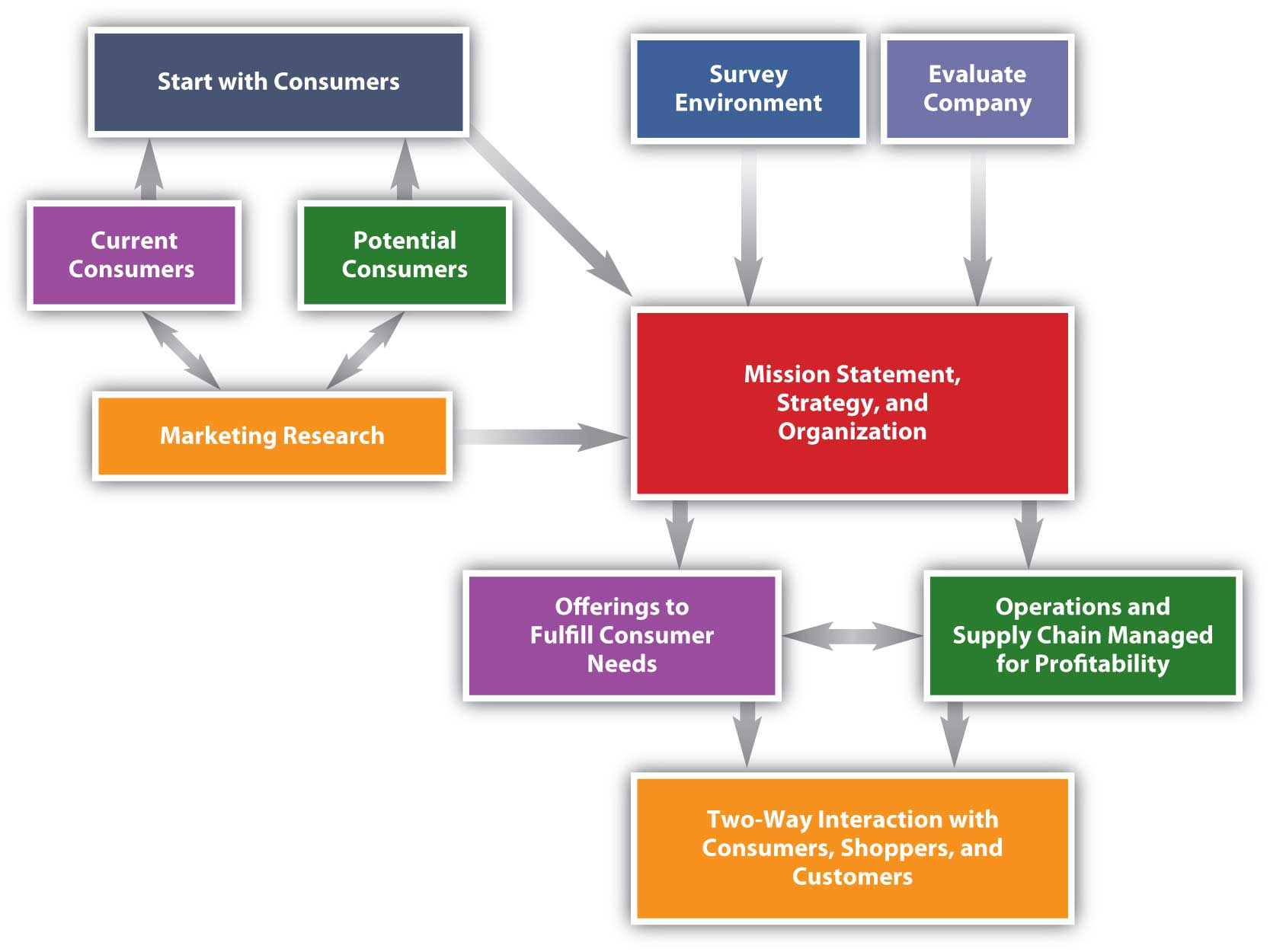1.4 Themes and Organization of This Book
Learning Objective
- Understand and outline the elements of a marketing plan as a planning process.
Marketing’s Role in the Organization
We previously discussed marketing as a set of activities that anyone can do. Marketing is also a functional area in companies, just like operations and accounting are. Within a company, marketing might be the title of a department, but some marketing functions, such as sales, might be handled by another department. Marketing activities do not occur separately from the rest of the company, however.
As we have explained, pricing an offering, for example, will involve a company’s finance and accounting departments in addition to the marketing department. Similarly, a marketing strategy is not created solely by a firm’s marketing personnel. Instead, it flows from the company’s overall strategy. We’ll discuss strategy much more completely in Chapter 2 “Strategic Planning”.
Everything Starts with Customers
Most organizations start with an idea of how to serve customers better. Apple’s engineers began working on the iPod by looking at the available technology and thinking about how customers would like to have their music more available, as well as more affordable, through downloading.
Many companies think about potential markets and customers when they start. John Deere, for example, founded his company on the principle of serving customers. When admonished for making constant improvements to his products even though farmers would take whatever they could get, Deere reportedly replied, “They haven’t got to take what we make and somebody else will beat us, and we will lose our trade1.” He recognized that if his company failed to meet customers’ needs, someone else would. The mission of the company then became the one shown in Figure 1.4 “Mission Statement of Deere and Company”.
Here are a few mission statements from other companies. Note that they all refer to their customers, either directly or by making references to relationships with them. Note also how these are written to inspire employees and others who interact with the company and may read the mission statement.
IBM
IBM will be driven by these values:
Dedication to every client’s success.
Innovation that matters, for our company and for the world.
Trust and personal responsibility in all relationships2.
Coca-Cola
Everything we do is inspired by our enduring mission:
To refresh the world…in body, mind, and spirit.
To inspire moments of optimism…through our brands and our actions.
To create value and make a difference…everywhere we engage3.
McDonald’s
To be our customers’ favorite place and way to eat4.
Merck
To provide innovative and distinctive products and services that save and improve lives and satisfy customer needs, to be recognized as a great place to work, and to provide investors with a superior rate of return5.
Not all companies create mission statements that reflect a marketing orientation. Note Apple’s mission statement: “Apple ignited the personal computer revolution in the 1970s with the Apple II and reinvented the personal computer in the 1980s with the Macintosh. Today, Apple continues to lead the industry in innovation with its award-winning computers, OS X operating system and iLife and professional applications. Apple is also spearheading the digital media revolution with its iPod portable music and video players and iTunes online store, and has entered the mobile phone market with its revolutionary iPhone.” This mission statement reflects a product orientation, or an operating philosophy based on the premise that Apple’s success is due to great products and that simply supplying them will lead to demand for them. The challenge, of course, is how to create a “great” product without thinking too much about the customer’s wants and needs. Apple, and for that matter, many other companies, have fallen prey to thinking that they knew what a great product was without asking their customers. In fact, Apple’s first attempt at a graphic user interface (GUI) was the LISA, a dismal failure.
The Marketing Plan
The marketing plan is the strategy for implementing the components of marketing: creating, communicating, delivering, and exchanging value. Once a company has decided what business it is in and expressed that in a mission statement, the firm then develops a corporate strategy. Marketing strategists subsequently use the corporate strategy and mission and combine that with an understanding of the market to develop the company’s marketing plan. This is the focus of Chapter 2 “Strategic Planning”. Figure 1.5 “Steps in Creating a Marketing Plan” shows the steps involved in creating a marketing plan.
The book then moves into understanding customers. Understanding the customer’s wants and needs; how the customer wants to acquire, consume, and dispose of the offering; and what makes up their personal value equation are three important goals. Marketers want to know their customers—who they are and what they like to do—so as to uncover this information. Generally, this requires marketing researchers to collect sales and other related customer data and analyze it.
Once this information is gathered and digested, the planners can then work to create the right offering. Products and services are developed, bundled together at a price, and then tested in the market. Decisions have to be made as to when to alter the offerings, add new ones, or drop old ones. These decisions are the focus of the next set of chapters and are the second step in marketing planning.
Following the material on offerings, we explore the decisions associated with building the value chain. Once an offering is designed, the company has to be able to make it and then be able to get it to the market. This step, planning for the delivery of value, is the third step in the marketing plan.
The fourth step is creating the plan for communicating value. How does the firm make consumers aware of the value it has to offer? How can it help them recognize that value and decide that they should purchase products? These are important questions for marketing planners.
Once a customer has decided that her personal value equation is likely to be positive, then she will decide to purchase the product. That decision still has to be acted on, however, which is the exchange. The details of the exchange are the focus of the last few chapters of the book. As exchanges occur, marketing planners then refine their plans based on the feedback they receive from their customers, what their competitors are doing, and how market conditions are changing.
The Changing Marketing Environment
At the beginning of this chapter, we mentioned that the view of marketing has changed from a static set of four Ps to a dynamic set of processes that involve marketing professionals as well as many other employees in an organization. The way business is being conducted today is changing, too, and marketing is changing along with it. There are several themes, or important trends, that you will notice throughout this book.
- Ethics and social responsibility. Businesses exist only because society allows them to. When businesses begin to fail society, society will punish them or revoke their license. The crackdown on companies in the subprime mortgage-lending industry is one example. These companies created and sold loans (products) that could only be paid back under ideal circumstances, and when consumers couldn’t pay these loans back, the entire economy suffered greatly. Scandals such as these illustrate how society responds to unethical business practices. However, whereas ethics require that you only do no harm, the concept of social responsibility requires that you must actively seek to improve the lot of others. Today, people are demanding businesses take a proactive stance in terms of social responsibility, and they are being held to ever-higher standards of conduct.
- Sustainability. Sustainability is an example of social responsibility and involves engaging in practices that do not diminish the earth’s resources. Coca-Cola, for example, is working with governments in Africa to ensure clean water availability, not just for manufacturing Coke products but for all consumers in that region. Further, the company seeks to engage American consumers in participating by offering opportunities to contribute to clean water programs. Right now, companies do not have to engage in these practices, but because firms really represent the people behind them (their owners and employees), forward-thinking executives are seeking ways to reduce the impact their companies are having on the planet.
- Service-dominant logic. You might have noticed that we use the word offering a lot instead of the term product. That’s because of service-dominant logic, the approach to business that recognizes that consumers want value no matter how it is delivered—whether through a tangible product or through intangible services. That emphasis on value is what drives the functional approach to value that we’ve taken—that is, creating, communicating, delivering, and exchanging value.
- Metrics. Technology has increased the amount of information available to decision makers. As such, the amount and quality of data for evaluating a firm’s performance is increasing. Earlier in our discussion of the marketing plan, we explained that customers communicate via transactions. Although this sounds both simple and obvious, better information technology has given us a much more complete picture of each exchange. Cabela’s, for example, combines data from Web browsing activity with purchase history in order to determine what the next best offer is likely to be. Using data from many sources, we can build more effective metrics that can then be used to create better offerings, better communication plans, and so forth.
- A global environment. Every business is influenced by global issues. The price of oil, for example, is a global concern that affects everyone’s prices and even the availability of some offerings. We already mentioned Coke’s concern for clean water. But Coke also has to be concerned with distribution systems in areas with poor or nonexistent roads, myriads of government policies and regulations, workforce availability, and so many different issues in trying to sell and deliver Coke around the world. Even companies with smaller markets source some or all their offerings from companies in other countries or else face some sort of direct competition from companies based in other countries. Every business professional, whether marketing or otherwise, has to have some understanding of the global environment in which companies operate.
Key Takeaway
A company’s marketing plan flows from its strategic plan. Both begin with a focus on customers. The essential components of the plan are understanding customers, creating an offering that delivers value, communicating the value to the customer, exchanging with the customer, and evaluating the firm’s performance. A marketing plan is influenced by environmental trends such as social responsibility, sustainability, service-dominant logic, the increased availability of data and effective metrics, and the global nature of the business environment.
Review Questions
- Why does everything start with customers? Or is it only marketing that starts with customers?
- What are the key parts of a marketing plan?
- What is the relationship between social responsibility, sustainability, service-dominant logic, and the global business environment? How does the concept of metrics fit?
1John Deere, “John Deere: A Biography,” https://www.deere.com/en_US/corporate/our_company/about_us/strategy/strategy.page (accessed October 12, 2015).
2IBM, “About IBM,” http://www.ibm.com/ibm/us/en (accessed December 3, 2009).
3The Coca-Cola Company, “Mission, Vision & Values,” http://www.thecoca-colacompany.com/ourcompany/mission_vision_values.html (accessed December 3, 2009).
4McDonald’s, “Our Company,” http://aboutmcdonalds.com/mcd/our_company/mcd_faq/student_research.html#1 (accessed December 3, 2009).
5Merck & Co., Inc., “The New Merck,” http://www.merck.com/about/Merck%20Vision%20Mission.pdf (accessed December 7, 2009).
6Apple, Inc., “Apple’s App Store Downloads Top 1.5 Billion in First Year,” http://www.apple.com/hk/en/pr/library/2009/07/14apps.html (accessed December 3, 2009).



